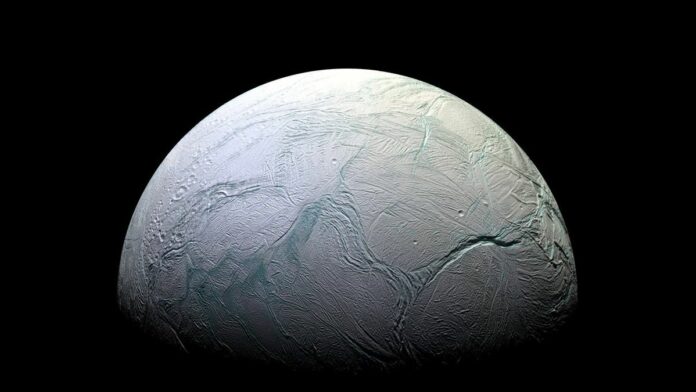It turns out there’s a corner in the Solar System almost suitable for life beyond Earth. NASA employees came to this conclusion in 2011. “Liquid water, carbon… and an energy source” exist on Enceladus, one of Saturn’s moons, says Chris McKay, an astrobiology expert.
His words are supported by samples taken from the surface of the celestial body. Analysis shows the presence of organic micro-particles, indicating the possible existence of simple life forms on Enceladus.
Interesting facts about Saturn’s moon Enceladus:
- Diameter: 500 km (0.1% of Saturn’s largest moon, Titan)
- Like Earth’s Moon, it is tidally locked to Saturn, always showing the same face.
- The moon orbits Saturn at a distance of 237,000 km.
- Discovered in 1789 by Englishman William Herschel, Enceladus was named after the mythological giant Enceladus, the son of Tartarus and Gaia. The name was proposed by Herschel’s son in 1847. Active exploration of Enceladus began after the Voyager spacecraft series approached it in the early 1980s. These missions provided numerous intriguing data that truly captivated scientists.
- In 2005, the American spacecraft Cassini approached Enceladus closely, reaching orbit around Saturn. Cassini completed its mission in 2017, transmitting 635 gigabytes of data and 450,000 images. From this data, it became clear that the moon is geologically active, with water and complex organic macromolecules.
- Why is it believed that life could exist on Enceladus? The average surface temperature of the moon is -200°C. At such a temperature, no known organism on Earth could survive. However, beneath Enceladus’ icy crust, there is an ocean at its south pole, with temperatures much higher: around -42°C. As depth increases, temperatures rise to around +1°C, which is sufficient for the emergence of simple life forms.
- Craters on the surface of Saturn’s sixth-largest moon are named after characters from the collection “One Thousand and One Nights.” For example, there is the Aladdin Basin, the Ali Baba Crater, the Scheherazade Fissure, and so on.
Saturn’s moon reflects 98% of the sunlight that reaches it, making Enceladus one of the brightest moons in the Solar System. - At the moon’s south pole, jets of vapor and dust burst out, breaking through the ice and forming unique ice geysers. Saturn’s gravity is likely the cause of such activity.
- Deep within Enceladus, there is an entire ocean of water, compositionally very similar to Earth’s salty liquid. However, it is heated not by the Sun, but by the warmth emanating from the moon’s interior. The estimated age of the sub-ice water body is over a billion years.
- It even has an atmosphere, albeit very thin. Humans wouldn’t be able to breathe there. In addition to Titan and Enceladus, the planet has 80 other moons, of which only 60 have been confirmed so far.
- In the 2030s, a new space mission to Enceladus is planned, with the main goal of more thorough exploration of Saturn’s moons. However, the landing craft is expected to land not on the surface of the sixth moon, but on Titan. The project is currently named the “Titan Saturn System Mission.” Apparently, NASA experts consider Titan more promising in terms of discovering life forms.
